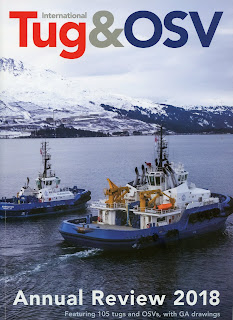Each year the ABR Company then publishes the International Tug + OSV Annual Review. It is very highly regarded in the tug and OSV sector as it highlights new vessels built during the past year all over the world. The 2018 version, just out, features thirty some vessels in great detail, describing the features and facts, with a high quality colour photo, and most fascinating to me, general arrangement drawings. These usually include a couple of deck plans and a profile.
This edition covers 105 vessels, with about 35 detailed accounts and the rest in capsule form with descriptions and photo.
Each year the review covers the newest developments in tug design, whether it is hull form or configuration or propulsion arrangement. This year several trends that have been in the making for some time are finally embodied in actual ships and it is fascinating to see how the various designers and shipyards have developed the concepts. Tugs and OSVs from all continents are covered. As expected Europe is covered widely, but so is North and South America, the Pacific and Asia, including the newly developing tug industry in Indonesia.
The cover photo of this year's Review features two tugs built to work in Prince William Sound, AK for Alyeska Pipeline Service Co. Edison Chouest Offshore operates the general purpose tug Elrington (left) and the mammoth escort tug Commander (the first of five for this contract). With 12,334 bhp and a 142 tonne bollard pull, the Commander has a free running speed of 15 knots. It also carries a suite of oil spill response gear and extensive fire fighting equipment.
The advent of LNG fuel figures into some of the new builds. There have also been more developments of the arrangement of propulsion units, whether ASD type thrusters or Voith Schneider. The first new build carousel tug is also featured, with its revolutionary ring mounted winch. Particularly for escort functions, the latest designs produce incredible power, generally in fairly small tugs. There is also tremendous development in northern regions and numerous ice class tugs have been delivered in the past year.
Not to be left out, and despite dire conditions in the oil patch, new OSVs are still coming out, many for highly specialized jobs, but they are also diversifying, particularly to work on offshore wind farms. Many of these vessels are equipped for 'walk to work', which allows safe transfer of workers from ship to offshore installation without using cranes and helicopters. Dynamic positioning of the ship and deployable gangways make servicing the offshore installations safe and convenient.
The International Tug + OSV Annual Review 2018, all colour, high grade paper, 114 pages, available from the ABR Company.
Their website is https://www.tugandosv.com/
.










